December 24, 2015 Ryukyu Shimpo
On December 23, a questionnaire carried out by the Ryukyu Shimpo and the Prefectural High School and Handicapped People’s School Teacher’s and Staff Union revealed that 28.9% of high school teachers and staff had noticed some students could not bring their own lunch or money for lunch to school. Further, 68.5% of teachers and staff also noticed there are students who cannot pay for educational materials or school fees. Teachers and staff answered that some students help with family expenses by working part-time. More than 90% of teachers replied that a family’s financial power affects the student’s academic performance. The survey shows the situation for children in poverty whose families do not have a stable livelihood and cannot guarantee even the minimum level learning environment.
The Teacher’s and Staff Union stressed the need for taking countermeasures and stated that schools have a limited capacity to support students and need to work together with external support institutions and specialists.
The students’ economic situation survey answered by teachers and staff was carried out from November 19 to December and targeted about 4,800 teachers and staff of 81 prefectural high schools and handicapped people’s schools (part-time, correspondence, and branch campus are counted separately). A total of 930 teachers and staff from 58 schools answered the questionnaire. (The collection rate was 19.4%.) The union had conducted a similar survey in 2010 (437 people replied; handicapped people’s schools were not included). They compared and analyzed both results.
Among teachers and staff, 28.9% (handicapped people’s schools were not included) answered “Yes” to the presence of students who did not bring lunch. This was 11.1% more than five years ago. And 68.5% of teachers and staff, including handicapped peoples’ schools, confirmed the presence of students who could not pay tuition fees, which has increased from the previous survey (61.3%). Meanwhile, answers that denied the presence of such students decreased from the earlier study (28.1%).
Nine out of 34 schools replied that five to 10% of students (two to four students in a class) work part-time to help a family. Six full-time high schools and one part-time high school answered that they had 25 to 30% (10 to 12 students in a class) of such students. Three full-time schools answered they had 30 to 40% (12 to 16 students).
To the question “Do you feel there has been an increase of students who have financial issues at home over the past five years?” 75.4% answered yes.
More than 50% of teachers and staff replied that they do not know a contact point for students in financial hardship. More than 60% (except handicapped people’s schools) answered that they noticed the increase of students who gave up on going to college for financial reasons.
In the free comments section, one of the teachers wrote, “Some of the students quit school because they were unable to pay the bus fare.” Another wrote, “Some of the students are too tired from part-time jobs to focus on studying.”
(English translation by T&CT and Megumi Chibana)
Go to Japanese

December 23, 2015 Ryukyu Shimpo
On December 22, the Okinawa Convention & Visitors’ Bureau (OCVB) presented its visitor arrival statistics projected for fiscal years 2015 to 2025. OCVB estimates that in fiscal 2021, tourist arrivals will exceed the 10 million-target figure set by the prefectural government, reaching 10.42 million visitors. Even within this current fiscal year, OCVB expects the total number to reach a record-high 7.75 million people, exceeding this year’s 7.6-million target.
From April to November 2015, an average 10.8% increase on the previous year was seen for the number of people who visited Okinawa. However, with regards to the off-peak period from December to next March, OCVB estimates the annual visitor arrival statistics to reach 7.75 million, an 8.2% year-on-year increase.
In addition, OCVB forecasts an average annual growth rate of 4.26% from fiscal 2016 through fiscal 2019. These figures are based on the long-term forecast of international tourism trends projected by the United Nations World Tourism Organization (UNWTO) and the average growth rate observed from fiscal 1996 through fiscal 2015.
With Naha Airport’s second runway scheduled to operate from March 2020, inbound and outbound flights are expected to increase by thirty thousand flights. By fiscal 2021, OCVB calculates 10.42 million visitor arrivals, crossing the 10 million-milestone for the first time.
Chokei Taira, President of OCVB, remarked enthusiastically, “These figures have given us hope and motivation to continue promoting tourism in various ways.”
(English Translation by T&CT, Kaya Doi)
Go to Japanese
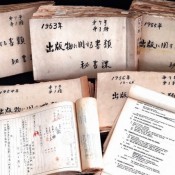
December 31, 2015 Ryukyu Shimpo by Mamoru Yasuda
As of December 30, a large quantity of documentation from the Government of the Ryukyu Islands regarding the regulation of freedom of speech under U.S. administration was discovered. These were documents handled by the Ryukyu government between January 1953 and June 1956, including applications to publish writings, official documents within the Ryukyu government, English-written letters of inquiry to the U.S. Civil Administration of the Ryukyu Islands (USCAR), and notices of authorization or lack thereof. Instead of being held at the Okinawa Prefectural Archives, the documents were preserved in an Okinawan household.
Official documents relating to publications were filed in volumes sorted by year. The years 1953 and 1954 each amounted to three volumes, 1955 was contained in two, and January through June of 1956 made up three volumes. There were eleven volumes consisting of 3,900 pages in total. These were designated as documents for permanent preservation within the secretarial division of the Government of the Ryukyu Islands.
Among the applications to publish were those for a political bulletin titled Jinmin (The People) written by politician Kamejiro Senaga of the local political party Okinawa Jinminto, and Kyoiku Shimbun (The Education Newspaper) proposed by Chobyo Yara, who would become chief executive of the Government of the Ryukyu Islands in 1968. There were even applications for school-specific writings such as literature written by students of University of the Ryukyus, reports of study abroad experiences in the U.S., Ryukyuan poetry, and high school literary magazines and newspapers.
When considering these applications, the Government of the Ryukyu Islands would repeatedly request investigations and records thereof from the Ryukyu police (formed under the Ryukyu government) about any applicant’s ideological tendencies, political affiliations, living arrangements, and personal relationships.
Aside from applications to publish, there were many other types of documents found. Applications to continue publishing periodicals, reports of discontinuing publications, and notifications of name alterations of publishers were also included. In addition there were directives to investigate for publication purposes handled by officials of the Government of the Ryukyu Islands in regional branch offices, notices of new proclamations, and other official documents and letters exchanged between administrative organs.
The numbers of confirmed applications and directives were 96 in 1953, 61 in 1954, 103 in 1955, and 75 in 1956 for a total of 335 documents. This includes not only publications that were authorized, but also applications that were not authorized or rejected.
In October 1953 the USCAR reevaluated all periodicals that had already been authorized for publication, and required each newspaper company or publisher to submit data and materials related to management of the operation, in addition to an application for continued publication. For one, the Ryukyu Shimpo submitted a register of all employees’ names.
At the time, the Government of the Ryukyu Islands was recognized by USCAR. Even if the Ryukyu government considered a publication allowable, however, if the USCAR did not, conditions would be added before authorization would be granted.
The discovered documents are suspected to have been stored at Okinawa Prefectural Government Headquarters. However, following Okinawa’s reversion to Japan, during the reconstruction of the Headquarters in the 1980s, these documents were probably removed to avoid damage dealt by demolition of old structures and not returned.
Naoki Monna, emeritus professor at Rikkyo University, has detailed knowledge of the regulation of freedom of speech under U.S. administration. While he was a graduate student in February 1966, he examined a portion of these documents himself, which were in storage at the Government of the Ryukyu Islands. He noted his surprise at the recent discovery of the documents, and mentioned that they reveal the fact that the U.S. military administration denied freedom of expression and speech that are fundamental human rights for Okinawans.
(English translation by T&CT and Erin Jones)
Go to Japanese
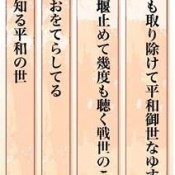
December 31, 2015 Ryukyu Shimpo
Ryukyu Shimpo Culture section’s Yasutake Onaha reports
The Ryukyu Shimpo is starting an initiative to collect poems that reflect aspects of Okinawa’s spiritual culture. Cultural aspects to be included in the poems include the desire for peace symbolized by the words “nuchi du takara (life is a treasure);” the spirit of mutual support contained in the word “yuimaru;” and the Okinawan people’s respect for ancestors and love of nature. The initiative follows Chunichi Shimbun and Tokyo Shimbun newspapers’ “Haikus of peace” initiative. We aim to share a spirit of peace from Okinawa to the rest of Japan and the world.
Uchinanchu (Okinawans) have continually striven for peace while bearing bitter memories of the Battle of Okinawa and facing a heavy burden of U.S. military bases. Uchinanchu have remained strong through the storms wrought by each consecutive generation, uniting to overcome many hardships.
This experience of overcoming hardships has birthed many poems and songs. These poems and songs can be thought of as the spiritual force behind Okinawa’s peace movement. The Ryukyu Shimpo hopes to expand the reach of this peaceful movement by sharing some of these songs and poems in the pages of our newspaper.
How would you express peace in Okinawa? Please send us your poetry. Together, we can build peace through heartfelt expression.
Poems of peace
Ryuka:
“Going forward from today
Military bases gone
A peaceful island
That is Okinawa’s wish”
(Takemitsu Maeda, Uruma City)
Tanka:
“The memories of
My 100-year old mother
Bottled up
Over and over again
I listen to stories of the war”
(Yoshiteru Higa, Yaese Town)
Haiku:
“The winter stars
Light up
Everyone’s faces”
(Ruri Miyayoshi, Naha City)
Senryu:
“Surviving a time of war
To know
A time of peace”
(Katsuyuki Ueda, Naha City)
(Translation by T&CT and Sandi Aritza)
Go to Japanese
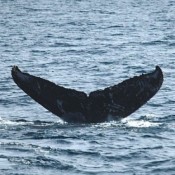
December 25, 2015 Hirokazu Otsubo Correspondent of Ryukyu Shimpo
On December 21, fishermen reported to the Zamami Whale Watching Association the appearance of two humpback whales. Association staff started looking from an observation point for signs of spray from a whale’s blowhole and successfully found a humpback whale.
They took a photograph of the whale and checked the pattern of its tail fin. The whale matched the association’s identification number Za-221. The whale has been identified several times since 2001. On December 14, the presence of a humpback whale was confirmed in Zamami for the first time this season. Zamami Whale Watching association restarted whale watching tours on December 27.
(English translation by T&CT, Hitomi Shinzato)
Go to Japanese
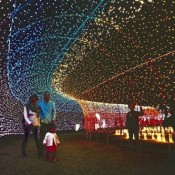
December 19, 2015 Ryukyu Shimpo
Tomigusuku Tourism Association started an event called the Illuminated Garden of Lights at Toyosaki Kaihin Park on December 12. The garden is illuminated from 6 p.m. to 10 p.m. The entrance fee for adults is 300 yen and it is free for junior high school students and those younger.
Tomigusuku Mayor, Haruki Gibo, and Chair of the tourism association, Tsutomu Oshiro, took part in the lighting ceremony. Visitors gave a cheer as the whole venue lit up.. and teenagers performed a dance before the ceremony.
There will be a countdown concert by DIAMANTES and fireworks on New Year’s Eve.
A nine-year-old visitor, Hoshinari Keruma, smiled as he commented, “The lights were colorful and shiny. It was very beautiful.”
(English translation by T&CT and Sayaka Sakuma)
Go to Japanese

December 25, 2015 Takahiro Miyagi of Ryukyu Shimpo,
Eighty-one-year-old WWII survivor Toshiko Kinjo is looking for her younger sister who was separated from her at an internment camp in Saipan in 1944. Kinjo is a director of a preschool in Nishihara Town, and her sister, Etsuko, was one year old when they were last together in Saipan. Kinjo said while she was working at preschools and kindergartens over the past 20 years people had asked her if she had taught at junior high schools. Kinjo thought, “They might have thought I’m my sister.”
Kinjo said, “I thought my sister might have passed away, but it is possible that she made it back to Okinawa as an orphan, was adopted by someone and lived with a different name. If I could see her again, I want to hug her tight for my mother and father, which she missed out on for 71 years, and apologize for not being able to find her.” Kinjo seeks any information related to a person who looks like her.
Kinjo is the oldest of five siblings. They moved around a mountainous area in Saipan for about one year, losing their mother, father, and a younger brother. Kinjo herself suffered malnutrition, but she survived and later reunited with her once-separated younger brother and sister at the internment camp. She was told that US soldiers took the youngest sister, Etsuko, to an orphanage. Kinjo could not look for her youngest sister due to the limited time and mobility during the year in the camp.
After the siblings returned to Okinawa on a US ship, they were taken care of by their relatives in Nago City. Etsuko, the youngest sister, has been missing ever since and is recorded as dead on a census register.
About 20 years ago, someone who she just met at a church asked Kinjo if her sister is a teacher. Around the same time, two young females ran to her and asked, “You taught Japanese at Nago Junior High School, didn’t you?” Kinjo thought at the time, “Some other person must look like me”. But about two years ago someone at a supermarket in Shuri, Naha City asked Kinjo, “Have you taught at Kamihara Junior High School?” Kinjo visited Nago Junior High School and Kamihara Junior High School to look at photos of the students from an approximate time the other teacher possibly worked there. She could not find anyone who looked like her sister.
Kinjo commented, “The war is a tragic memory which we could not even talk about among the siblings, but I do not want to have regrets. If my sister was able to return to Okinawa thanks to kind people and was raised to become a teacher, I would like to thank the adopted parents.”
If you have any information related to Toshiko Kinjo’s sister, please contact Ryukyu Shimpo at 098-865-5158.
(English translation by T&CT and Sayaka Sakuma)
Go to Japanese
December 24, 2015 Ryukyu Shimpo
On December 21, the city council of Cambridge, Massachusetts in the northeastern United States passed a resolution opposing the construction of a new base in Henoko, Nago as part of the relocation of U.S. Marine Corps Air Station Futenma. It was the second such resolution passed by a city council in the United States, following the resolution by the Berkeley, California city council in September opposing the new base construction and pledging solidarity with Okinawa. The text of the Cambridge resolution is almost the same as that of the Berkeley resolution. More and more U.S. city councils are taking an interest in the issue, with the city council of Honolulu, Hawaii also planning to consider a proposed resolution opposing the Henoko base construction in January 2016.
The resolution passed by the Cambridge city council explains that one quarter of the people of Okinawa were killed in the Battle of Okinawa in 1945. It also describes how the United States has maintained a massive military presence on Okinawa since the end of World War II, and how even after the U.S. military occupation of Japan ended, the Government of Japan encouraged the United States to continue to administer Okinawa.
Explaining that the Okinawan people and Governor Takeshi Onaga oppose the Henoko relocation plan, and that the plan endangers the biologically rich ecosystem of Oura Bay, the statement then declares: “The Council of the City of Cambridge joins Okinawan citizens to call upon the Government of the United States…to ensure the following steps be taken in accordance with US laws and procedures.”
The resolution is signed by Mayor Tom Bates of Cambridge and has been sent to Massachusetts Congressman Michael Capuano, Senators Elizabeth Warren and Edward Markey, U.S. Secretary of Defense Carter, Secretary of State Kerry, and President Obama. When the resolution proposal was under consideration, testimony was given before the city council by politics and national security scholar Joseph Gerson, Ph.D., of the American Friends Service Committee. Gerson is a signatory of recent statements by overseas intellectuals opposing the Henoko base construction.
The city of Cambridge has a population of around 100,000. It is home to Harvard University and the Massachusetts Institute of Technology.
(English translation by T&CT and Sandi Aritza)
Go to Japanese
December 24, Ryukyu Shimpo Sakae Toiyama reports from Washington, DC
Seventy American intellectuals, including film director Oliver Stone and linguist Noam Chomsky, issued a public statement on December 22 criticizing U.S. ambassador to Japan Caroline Kennedy for her comments on December 17 relating to MCAS Futenma at a press conference at Japan National Press Club. Part of the statement says that Kennedy’s comment regarding the Henoko relocation plan is “…at once a threat, an insult and a challenge for the vast majority of Okinawans who are vehemently opposed to the plan and [shows] brazen disregard for the law, the environment, and the outcome of elections.” Furthermore, the statement addressed ceasing construction of the replacement facility at Henoko with the words: “…as American citizens we insist that the government stop forcefully denying basic human rights … to the citizens of Okinawa.”
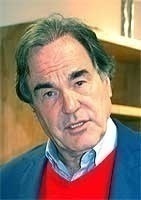
Oliver Stone

Noam Chomsky

Morton H. Halperin
This is the fourth time intellectuals from abroad have issued a public statement in regards to Henoko relocation of MCAS Futenma. This particular statement, however, comes from U.S. intellectuals protesting comments by Ambassador Caroline Kennedy made in her capacity as a representative of the U.S. government. Oliver Stone has signed onto previous statements, but this time he has been joined by new signatories. These include a U.S. negotiator on the 1971 Okinawa reversion agreement Morton H. Halperin, former U.S. diplomat and retired Army Reserve Colonel Ann Wright, and former U.S. Senator Mike Gravel.
In relation to the Henoko relocation plan being advanced by the governments of the U.S. and Japan, the statement made the point that, “MCAS Futenma must be closed, but moving it to Henoko isn’t the solution. It merely shifts the problem to a less conspicuous location, introducing environmental and safety threats to another part of the island and reinforcing Okinawa’s role as a U.S. military bastion.”
Full text of U.S. Citizens’ Response to Ambassador Caroline Kennedy’s Statement of Support for the Henoko Plan
In her December 17 Tokyo press conference, U.S. Ambassador to Japan Caroline Kennedy faithfully parroted Obama administration’s contention, saying that building a new U.S. marine base at Henoko in Okinawa is “the best of any other plan considered.”
After cordial comments about the U.S. striving to “be good neighbors” and “working hard to reduce the impact” of the dozens of U.S. bases that occupy almost 20 percent of the land mass of Okinawa Island, Kennedy declared her support for the base that Okinawans have been protesting against tirelessly and in the face of brute physical force and intimidation for hundreds of days.
Asked what she thinks about the Okinawan people’s overwhelming opposition to the base construction and if the U.S. would consider an alternative plan, Kennedy replied: “People worked very hard, considered many options to develop this plan [for closing and relocating the U.S. marine base currently located in highly populated Ginowan] that I think is the best of any other plan that was considered.”
Kennedy’s statement that the U.S. wants to close Futenma and build at Henoko as fast as possible is at once a threat, an insult and a challenge for the vast majority of Okinawans who are vehemently opposed to the plan and the brazen disregard for the law, the environment and the outcome of elections. MCAS Futenma must be closed, but moving it to Henoko isn’t the solution. It merely shifts the problem to a less conspicuous location, introducing environmental and safety threats to another part of the island and reinforcing Okinawa’s role as a U.S. military bastion.
At the end of the press conference, Kennedy was invited to sign the Press Club’s guest book beside a quotation from her father, President John F. Kennedy. The ambassador obliged the request with a JFK quote about press freedom.
During her press conference, Kennedy stubbornly, if politely, regurgitated the U.S.’s insistence on forcing Henoko despite mounting protests and an active lawsuit. Ambassador Kennedy should have selected a quote from President Kennedy’s 1963 Commencement Address delivered at American University in which he offered a powerful and compelling argument for world peace.
“Every thoughtful citizen who despairs of war and wishes to bring peace,” President Kennedy said, “should begin by looking inward — by examining his own attitude toward the possibilities of peace…”
Ambassador Kennedy serves as a public microphone for U.S. elected officials, policymakers, and military leaders who have neither the guts nor the gumption to honestly or honorably address the concerns of Okinawans. She should reread her father’s speech wherein he rejects a “Pax Americana enforced on the world by American weapons of war.”
If she were to do so, Ambassador Kennedy would be reminded that her father asked, “Is not peace, in the last analysis, basically a matter of human rights — the right to live out our lives without fear of devastation — the right to breathe air as nature provided it — the right of future generations to a healthy existence?”
Because those words still have meaning to us, as American citizens we insist that the U.S. government stop forcefully denying basic human rights, including self-determination and living in a healthy, safe environment, to the citizens of Okinawa.
List of U.S. signatories to the above statement:
1. Christine Ahn, Women Across DMZ
2. Gar Alperovitz, Co-Chair The Next System Project, former Lionel R. Bauman Professor of Political Economy, University of Maryland
3. Christian G. Appy, Professor of History, University of Massachusetts
4. Sandi Aritza, Translator
5. Davinder Bhowmik, Associate Professor of Modern Japanese Literature, University of Washington
6. Herbert Bix, Emeritus Professor of History and Sociology, State University of New York at Binghamton
7. Courtney B. Cazden, Professor Emeritus, Harvard University
8. Noam Chomsky, Professor Emeritus of Linguistics, Massachusetts Institute of Technology
9. Marjorie Cohn, Professor, Thomas Jefferson School of Law
10. Elizabeth Cori-Jones, M.Ed. (Harvard)
11. Frank Costigliola, Professor of History, University of Connecticut
12. Fr Bob Cushing, Pastor at St Joseph Church, Georgia
13. Sasha Davis, Assistant Professor, Keene State College
14. Jean Downey, M.A., J.D., Contributing Editor, Kyoto Journal
15. Alexis Dudden, Professor of History, University of Connecticut
16. Richard Falk, Milbank Professor of International Law Emeritus, Princeton University
17. John Feffer, Director, Foreign Policy In Focus
18. Norma Field, Professor Emerita, University of Chicago
19. Max Paul Friedman, Professor of History, American University
20. Bruce K. Gagnon, Coordinator, Global Network Against Weapons & Nuclear Power in Space
21.Daniel H. Garrett, Former U.S. Department of State Foreign Service Officer; Senior Associate, The Asia Institute
22. Joseph Gerson, PhD, Working Group for Peace & Demilitarization in Asia and the Pacific
23. Gary R. Goldstein, Professor, Tufts University
24.Mike Gravel, U.S. Senator (1969-1981)
25. Mel Gurtov, Professor Emeritus of Political Science, Portland State University
26. Morton H. Halperin, Political Scientist
27. Laura Hein, Professor Northwestern University
28.Dud Hendrick, Deer Isle, Maine, Member of VFP 2015 delegation to Okinawa
29.Mickey Huff, Professor of History, Diablo Valley College, Director of Project Censored
30.Pat Hynes, Director, Traprock Center for Peace and Justice, Massachusetts, USA
31.Kyle Ikeda, Associate Professor of Japanese, University of Vermont
32.Vincent Intondi, Associate Professor of History, Montgomery College
33. Xeni Jardin, Technology Journalist
34. Rebecca Jennison, Dept. of Humanities, Kyoto Seika University
35. John Junkerman, Documentary Filmmaker
36. Sheila K. Johnson, Anthropologist
37.Kyle Kajihiro, Board Member, Hawaiʻi Peace and Justice
38.Tarak Kauff, Veterans For Peace, Board of Directors
39.Peter Kuznick, Professor of History, American University
40.Barry Ladendorf, National President, Veterans for Peace
41.Joe Lauria, former Wall Street Journal United Nations correspondent
42.Jon Letman, Journalist
43.Stanley Levin, Korean War Veteran and member of the VFP 2015 delegation to Korea
44.C. Douglas Lummis, Visiting Professor, Okinawa Christian University Graduate School
45.Catherine Lutz, Professor, Brown University
46. Andrew R. Marks, M.D., Professor of Columbia University
47.Kenneth E. Mayers, Major USMCR (Ret’d), Member of the VFP 2015 Delegation to Okinawa
48.Yosi McIntire, lifetime student
49. Katherine Muzik, Marine Biologist, Kaua’i
50. Khury Petersen-Smith, doctoral candidate, Clark University School of Geography, Massachusetts
51.Robert Naiman, Policy Director, Just Foreign Policy
52.Koohan Paik, Program Director, International Forum on Globalization
53. Samuel Perry, Associate Professor, Brown University
54.Margaret Power, Professor of History, Illinois Institute of Technology
55.Craig Quirolo, Founder, Rape Relief
56. Steve Rabson, Professor Emeritus, Brown University
57.Betty A. Reardon. Ed.D., Founding Director Emeritus, International Institute on Peace Education
58.Lawrence Repeta, Member, Washington State Bar Association
59.Coleen Rowley, retired FBI Agent and former Minneapolis Division Legal Counsel
60.Arnie Saiki, Moana Nui Action Alliance
61.Pete Shimazaki Doktor, Hawai`i Okinawa Alliance & Veterans for Peace Ryukyu Working Group co-founder
62.Tim Shorrock, Journalist and trade unionist
63.Alice Slater, World Beyond War, Coordinating Committee
64. John Steinbach, Hiroshima/Nagasaki Peace Committee of the National Capital Area to the Citizen’s Response
65. Oliver Stone, Academy Award-winning Filmmaker
66.David Swanson, Author
67.Roy Tamashiro, Professor, Webster University
68.Eric Wada, Ukwanshin Kabudan Director, President
69.Lawrence Wittner, Professor of History Emeritus, State University of New York at Albany
70. Ann Wright, retired U.S. Army Reserve Colonel and former U.S. diplomat who resigned in 2003 in opposition to the Iraq War
(English translation by T&CT and Erin Jones)
Go to Japanese
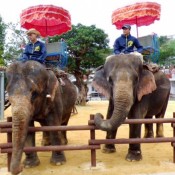
December 17, 2015 Ryukyu Shimpo
On December 16, Tonsai and Boonthong, Asian elephants from Tohoku Safari Park in Fukushima Prefecture, were showcased at Okinawa Zoo and Museum. They became Okinawa-Fukushima Friendship Elephants last year and came to Okinawa to spend the winter season.
The two elephants will interact with children through elephant rides and tug-of-war and will go back to Fukushima mid-March next year.
Tonsai and Boonthong left Fukushima on December 8 and arrived in Okinawa on December 13. They are full of energy and took a walk with children on their backs right after their arrival at the zoo.
Elephant keeper Toshiki Kagaya, who came with the two elephants from Tohoku Safari Park, said, “Since the two elephants arrived in Okinawa, they eat well and are happy to eat sugar canes. I want them to interact with children through elephant rides and feeding too.”
(English translation by T&CT, Hitomi Shinzato)
Go to Japanese
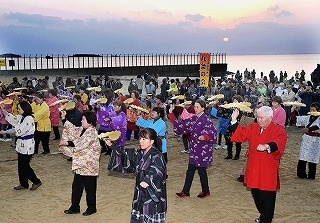










 Webcam(Kokusai Street)
Webcam(Kokusai Street)


